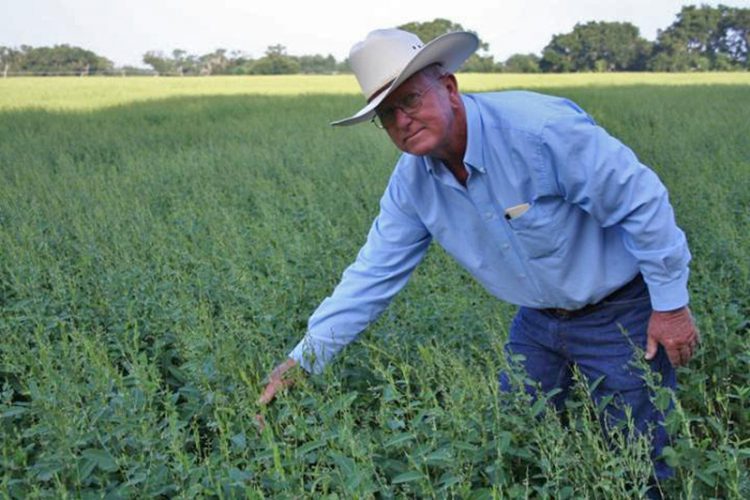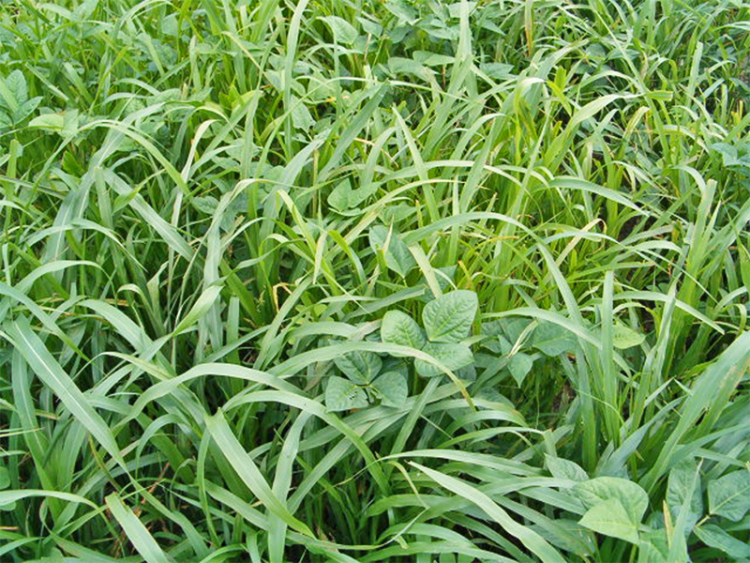Ann Blount, Forage Breeder, NFREC
While most people are staying safely distanced from the world at home, those of us lucky enough to live on farms haven’t struggled with lack of activities, exercise and sunshine. I can tell based on the increase in phone calls to my office about spring planting of pastures and seed purchases. Farmers are positively focused on the day to day tasks, with many looking forward to summer grazing, wildlife food plots, cover crops, and bee pastures. This article will cover just a few of the more common summer legume forages that are adapted to the Florida Panhandle and sources for more information, should you desire more detail about the plants and their management.
There are several adapted high-quality, summer forage legumes well-suited for North Florida. Aeshynomene, alyceclover, cowpea, and forage soybeans, are just a few of the possibilities for summer planting. Remember that legume plantings may require rhizobium inoculation in order for nitrogen fixation to occur.
–
Common Aeschynomene – Aeschynomene americana
Aeschynomene is one of my absolute favorite summer annual legumes. It is best adapted to wetter locations, but has been grown successfully in Southern Alabama and Georgia, so it does have enough cold tolerance to grow and regenerate in North Florida. While producers in South Florida are more familiar with aeschynomene, several local seed suppliers do have seed in their inventories available now. There are two species of this legume on the market, Aeschynomene americana, also known as “common” aeschynomene, joint vetch or deer vetch, and Aeschynomene evenia (no common known name). I am referring to Aeschynomene americana (common), which is a native legume to Florida. Aeschynomene americana is a reseeding annual that flowers and produces seed in early fall in North Florida. Plants typically dieback after the seed has matured. If you manage the plants to allow mature seed production, the stand should be productive for several years following the establishment year. Common aeschynomene offers excellent forage quality, and is highly palatable to livestock and wildlife. Generally the seed is sold “coated” (inoculant), and “dehulled” (scarified) for around $4.00/lb, with discounts available for bulk purchases ($170.00/50 lbs). A gentle reminder to be sure to check the label for weed seed and, because this legume is hard-seeded, the percent germination. Seeding rate recommendations for Florida are 6-8 lbs/A (dehulled).
For more information, use the following links: aeschynomene for forage, or for quality deer management.
–
Alyceclover – Alysicarpus vaginalis
Alyceclover is a popular legume for use as a hay and cover crop in Southeastern U.S. While it is a non-native (native to Asia), this plant is well adapted to North Florida, and has been successfully utilized as a summer hay crop, often planted on cultivated fields following cool-season grasses for grazing, silage or hay. It is not popular with row-crop producers, because it is difficult to eradicate in peanut fields. It could also be a troublesome weed in perennial peanuts, if producers want a pure stand for horse hay sales. Do not consider planting alyceclover if it will conflict with your current cropping systems.
Alyceclover is not a true clover (true clovers are typically cool-season legumes), but rather it is a warm-season legume that has spreading branches that may grow to a height of 60″, if not mowed or harvested for hay. Alyceclover is a heavy seed producer and will easily reseed, if allowed to develop mature seed in the fall. Grazing or harvesting for hay would prevent most seed production, so if reseeding is desirable, the plant must be managed to allow for seed to mature and scatter before frost.
Alyceclover grows well on fertile, well-drained soils, and is not tolerant of wet, or poorly drained soil conditions. Alyceclover is also susceptible to root-knot nematode, so we recommend growing this clover in rotation with other hay or pasture plants to avoid loss due to this pest. In the past, a strain of alyceclover was developed at the University of Florida that had improved tolerance to root-knot nematode, however it was not marketed and is not commercially available. Common alyceclover is sold on the commercial market. Seed prices range depending on quantity purchased. Several seed producers list their pricing from about $2.00-$2.50/lb, but it varies depending on use as a hay crop or for wildlife purposes. Current listing I found were $27.00/5 lbs (or $5.40/lb). Recommended seeding rates for Florida are 12-15 lbs/A.
For additional information, use the following links for Alyceclover forage or wildlife plots.
–
Cowpea – Vigna unguiculata
Cowpea is a very popular summer legume pea. Most of us know this plant as “Iron-Clay Pea”, but this plant is actually a common cowpea, that is an easy to grow summer legume that is widely available on the commercial market. While it is extremely popular for wildlife food plots, it is sometimes grown for silage in a blend with corn. The viney cowpea grows well in a mixed planting. Cowpeas may also be grazed, however the plant tends to be weak, so close grazing will stunt its viney growth habit. Some producers have successfully grown cowpea as a cover crop, or cut cowpea for hay. As a hay crop, the stems will require additional drying time, so it will be best to utilize a mower conditioner, or wait for a weather forecast with extended drying time prior to baling. Iron-clay pea seed is still available this year, but supplies are limited. This year’s prices are a few dollars more than previous years and are quoted locally at $36.00-$38.00/50 lbs. Recommended seeding rate for monoculture planting is 60-90 lbs/A.
There are also some newcomers to the cowpea family, ‘Red Ripper’ and ‘Chinese Red’. Red Ripper Cowpeas supposedly are more drought and heat tolerant than common iron-clay pea, and are widely adapted to many soil types. Red Ripper is considered to be a determinant flowering variety, and may flower earlier than common cowpea. Chinese Red is another cowpea type that several North Florida livestock producers are excited about. Both of these cowpeas are more bush types, while common cowpea has more viney growth. Local prices vary for Red Ripper and Chinese Red, but I was able to locate seed at $45.00-$46.00/50 lbs. Recommended seeding rates may be slightly lower than that of cowpea, but again, that depends on the purpose of the planting. So, in the case of both Red Ripper and Chinese Red cowpeas, we lack adequate field experience to confirm any claims of their increased productivity under North Florida conditions. Additional information on the growth habit and comparative yield with common cowpea is available at: Cowpea Cover Crop Information Sheet, and Evaluation of Cowpea and Mung Bean Varieties.
–
–
For additional information on cowpeas, use the following links for: cover crop, red ripper , wildlife food plot
–
Forage soybeans – Glycine max
While grain-type soybeans were once the rage in North Florida, acreage declined in the state due to issues with poor market prices, low yields, disease, insect, and nematode-related problems. However, forage soybeans do grow extremely well in North Florida, and have been, in my opinion, under utilized and overlooked. Forage soybeans may be grown for use as a high-protein forage for grazing, haying or ensiling. Adapted varieties should provide forage with qualities similar to alfalfa. Inexpensive seed makes this summer legume an excellent choice for livestock and wildlife. There are several forage soybean varieties available on the local market, however seed is generally not on the shelves in the store, and will need to be special ordered for local delivery. There are GMO (Roundup Ready) varieties, as well as the more common non-GMO types like Tyrone and Laredo. Seed ranges widely in both availability and price. One local quote offered non-GMO forage soybeans at $45.00/50 lbs. Recommended seed rates for Florida are 30-100 lbs/A, depending on intended use for grazing, hay, cover crop, silage or use for wildlife purposes.
Additional information on forage soybeans is avialable in the following publications: UF/IFAS Forage Soybeans, and Progressive Forage Forage Soybeans
–
For additional reading related to these crops:
Planting dates, rates and methods of agronomic crops
Rhizobium inoculations information
Annual warm season legumes
- Cool-Season Forages – A Pasture Perspective for 2022 - September 16, 2022
- Ornamental Rhizoma Perennial Peanut for Groundcover or Alternative Turf - March 18, 2022
- 2021 Cool-Season Forage Recommendations for Livestock and Wildlife - September 24, 2021




